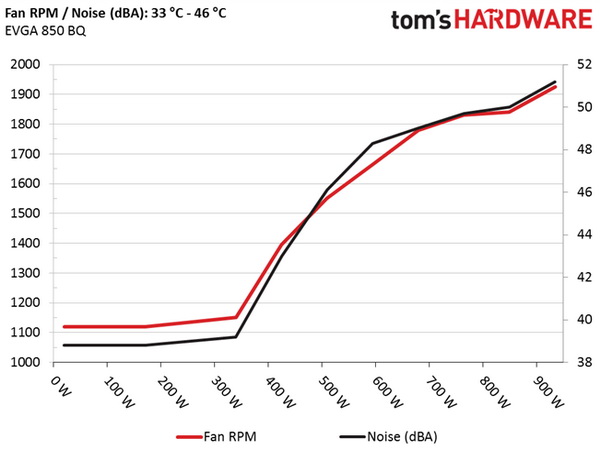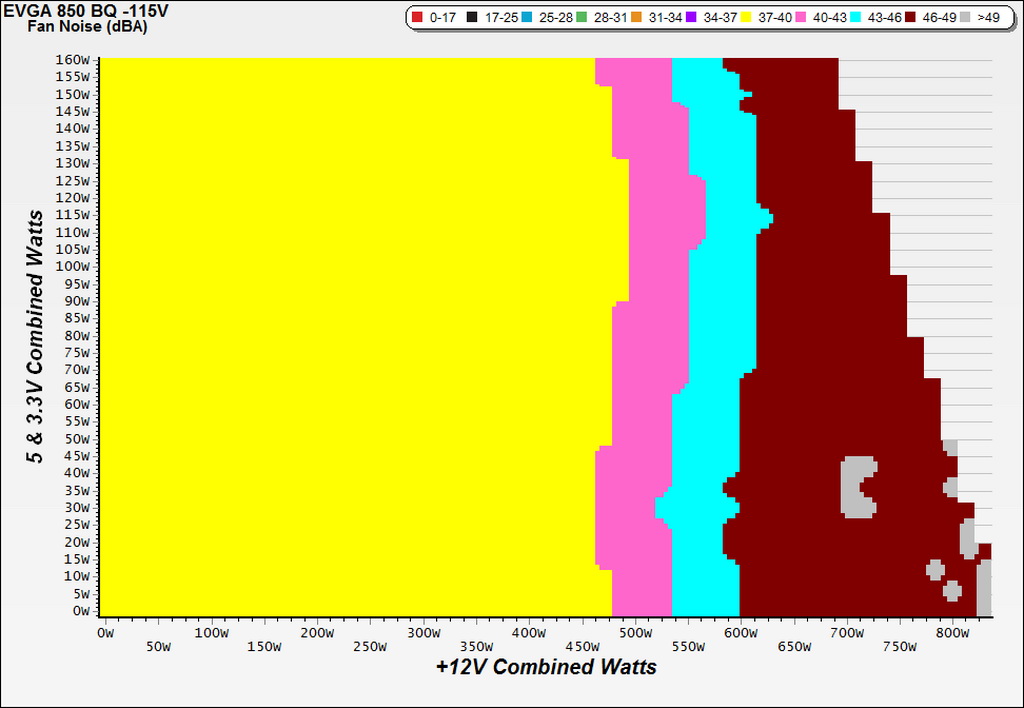EVGA BQ Series 850W PSU Review
One of EVGA's most affordable power supply families, the BQ, includes five unique models. The higher-capacity ones are made by HEC and the rest come from Andyson. Today we're testing the flagship 850 BQ.
Why you can trust Tom's Hardware
Efficiency, Temperature, And Noise
Efficiency
Our efficiency testing procedure is detailed here.
Using the results from the previous page, we plotted a chart showing the 850 BQ's efficiency at low loads, and loads from 10 to 110 percent of its maximum-rated capacity.




The efficiency difference between 115V and 230V is quite large. Usually it is around 2%, but in this PSU it reaches an impressive 2.71%. Compared to other Bronze-rated units, the 850 BQ takes the lead from Corsair's CX750M and is notably behind the CX650M.
Efficiency At Low Loads
In the following tests, we measure the 850 BQ's efficiency at loads significantly lower than 10 percent of its maximum capacity (the lowest load the 80 PLUS standard measures). The loads we dialed were 20, 40, 60, and 80W. This is important for representing when a PC is idle, with power-saving features turned on.
| Test # | 12V | 5V | 3.3V | 5VSB | DC/AC (Watts) | Efficiency | Fan Speed | Fan Noise | PF/AC Volts |
|---|---|---|---|---|---|---|---|---|---|
| 1 | 1.187A | 0.480A | 0.467A | 0.195A | 19.59 | 61.07% | 1120 RPM | 38.8 dB(A) | 0.943 |
| 12.261V | 5.116V | 3.421V | 5.056V | 32.08 | 115.1V | ||||
| 2 | 2.404A | 0.968A | 0.965A | 0.396A | 39.70 | 71.79% | 1120 RPM | 38.8 dB(A) | 0.972 |
| 12.254V | 5.108V | 3.416V | 5.047V | 55.30 | 115.1V | ||||
| 3 | 3.625A | 1.465A | 1.465A | 5.037A | 59.86 | 77.14% | 1120 RPM | 38.8 dB(A) | 0.973 |
| 12.247V | 5.100V | 3.410V | 5.037V | 77.60 | 115.1V | ||||
| 4 | 4.833A | 1.964A | 1.936A | 0.795A | 79.75 | 80.47% | 1120 RPM | 38.8 dB(A) | 0.984 |
| 12.239V | 5.094V | 3.405V | 5.029V | 99.11 | 115.2V |
The fan's speed is insanely high for such light loads. If you want a silent PSU, you'd better stay away from this one. Moreover, the efficiency levels are quite disappointing under loads lower than 60W. It's only during the last test that the 850 BQ passes 80% efficiency.
5VSB Efficiency
The ATX specification states that 5VSB standby supply efficiency should be as high as possible, recommending 50 percent or higher efficiency with 100mA of load, 60 percent or higher with 250mA of load, and 70 percent or higher with 1A or more of load.
We take four measurements: one each at 100, 250, and 1000mA, and one with the full load the 5VSB rail can handle.
Get Tom's Hardware's best news and in-depth reviews, straight to your inbox.
| Test # | 5VSB | DC/AC (Watts) | Efficiency | PF/AC Volts |
|---|---|---|---|---|
| 1 | 0.102A | 0.52 | 73.24% | 0.096 |
| 5.060V | 0.71 | 115.1V | ||
| 2 | 0.252A | 1.27 | 76.05% | 0.195 |
| 5.056V | 1.67 | 115.1V | ||
| 3 | 1.002A | 5.05 | 78.54% | 0.352 |
| 5.035V | 6.43 | 115.1V | ||
| 4 | 3.002A | 14.98 | 76.98% | 0.432 |
| 4.991V | 19.46 | 115.1V |


The 5VSB rail's efficiency is decent given this unit's entry-level efficiency certification.
Power Consumption In Idle And Standby
In the table below, you'll find the power consumption and voltage values of all rails (except -12V) when the PSU is idle (powered on, but without any load on its rails), and the power consumption when the PSU is in standby mode (without any load, at 5VSB).
| Mode | 12V | 5V | 3.3V | 5VSB | Watts | PF/AC Volts |
|---|---|---|---|---|---|---|
| Idle | 12.247V | 5.121V | 3.433V | 5.061V | 7.15 | 0.609 |
| 115.1V | ||||||
| Standby | 0.05 | 0.007 | ||||
| 115.1V |


Phantom power is very low with both voltage inputs.
Fan RPM, Delta Temperature, And Output Noise
Our mixed noise testing is described in detail here.
The first chart below illustrates the cooling fan's speed (in RPM), and the delta between input and output temperature. The results were obtained at 33°C (91.4°F) to 46°C (114.8°F) ambient temperature.
The next chart shows the cooling fan's speed (again, in RPM) and output noise. We measured acoustics from one meter away, inside a small, custom-made anechoic chamber with internals completely covered in sound-proofing material (be quiet! Noise Absorber kit). Background noise inside the chamber was below 18 dB(A) during testing, and the results were obtained with the PSU operating at 33°C (91.4°F) to 46°C (114.8°F) ambient temperature.
The following graph illustrates the fan's output noise over the PSU's operating range. The same conditions of the above graph apply to our measurements, though the ambient temperature was between at 28°C (82.4°F) to 30°C (86°F).
The PSU could be much quieter with a proper fan profile. However, HEC decided to increase its reliability by making the fan spin at 1120 RPM, minimum. With loads higher than 600W, and even under normal temperature conditions, you will probably need ear plugs to tolerate the fan's noise.
Current page: Efficiency, Temperature, And Noise
Prev Page Load Regulation, Hold-Up Time, And Inrush Current Next Page Protection Features, Evaluated
Aris Mpitziopoulos is a contributing editor at Tom's Hardware, covering PSUs.
-
Metteec Also, for $20 more, you can pick up an equivalent gold rated PSU or maybe even a platinum one on sale and after rebates. It is the halcyon days for competition in quality PSUs.Reply -
_TheD0ct0r_ Reply19020704 said:Thanks for the review. Looks like I will be avoiding this one.
Why is that?
-
Metteec @_THEDICTOR_, for $85, there are so many other better options. EVGA could have been more competitive model if they made quieter version. Instead, you get a PSU with fixed cables, low efficiency, high power variances, and noise like a mini-vacuum. While the higher quality capacitors and warranty are nice, the lack of utility does not make this a good value. 3-years ago, this would have been a great PSU, but times have changed. It is a great day to buy a PSU, just not this one.Reply -
MasterMace appears to be another terrible unit. I'll have to read back and see if it's an Andyson or a HECReply -
Nuckles_56 I would have thought that EVGA could have pushed HEC a bit harder and got a much better unit out of them than thisReply -
lunyone I would personally like to see more 450-550w PSU reviews, not the cherry picked and delivered 750w+ ones that seem to make the rounds. It is just that most people are only going to need 450-550w PSU's for their 1 dGPU based systems.Reply -
Aris_Mp This is not a cherry-picked sample. It comes directly from a store shelf and not from EVGA.Reply
As for more 450-550W PSU reviews, I am currently working on a 500W unit (which however isn't affordable).


